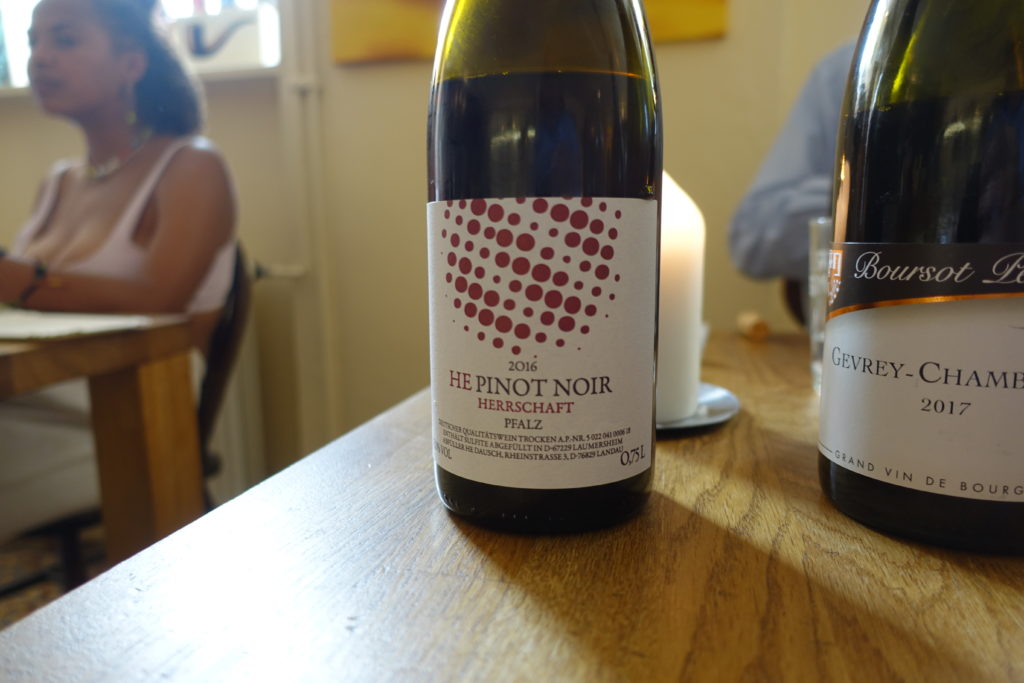Darf ich mich vorstellen:
Hans Erich Dausch
Weinberater
Meine Philosophie:ein Wein muss für mich elegant,
subtil und den Ausdruck seiner Umgebung wiederspiegeln.
Finesse und Eleganz haben vor
Alcohol und übertriebener Dichte zu stehen.
Eine Flasche muss Lust auf die Nächste machen!

The introduction above, by Hans Eric Dauch, shows that he’s a vigneron with his heart in the right place and an understanding of hedonistic, enjoyable wines. His raison d’être is that one bottle should give you the craving – or even lust – for the next. Also, that high alcohol and excessive intensity have nothing to do with finesse and elegance.
This could be taken directly from the Winehog’s definition of a vin d’emotion.
HE
HE, as Dauch is known in Germany (mainly by sommeliers and geeks), is recognised as one of the country’s best pinot noir producers, and in recent years he’s received several awards for his wines. He’s a must-know if you really like pinot noir.
Via his Danish importer, Rufus Vin, I had the pleasure of tasting three cuvees from Hans Eric Dauch, and while I had heard rumours about the high quality of the wines, I was rather shocked, especially by the wines’ overt and lovely drinkability. At least two of them had true emotional qualities. Even the third (a bit closed on a root day) had some fine hedonistic qualities, although it didn’t create the craving for another bottle.
Former banker and ski instructor
Hans Erich Dauch’s estate is located in Landau, between Mannheim and Karlsruhe south of Frankfurt.
He was formerly in the banking business (just like the Winehog), but has also worked as a ski instructor, which is not something the Winehog has done since the Alps appeared.
Dauch is above all interested in wine from a hedonistic standpoint, and this shows in the wines he produces.
The vineyard and the vines
The starting point is the 1.2 hectares of family vineyards he has – quite a small estate, but with some interesting vines. It revolves around the vineyards Eschbacher Hasen and Herrschafft, both located at 200-230 meters above sea level with perfect sun exposure to the east/southeast. The vegetal material is mainly the Mariafelder clone on SO4 rootstock, but for his l’Artiste cuvee, the Geisenheimer a is used.
He produces four wines: one from Herrschafft and two from Eschbacher Hasen. One of the latter is named Eschbacher Hasen, while the other is the HE Pinot Noir cuvee from the core of the vineyard. In recent years, a new top wine – l’Artiste – has been produced in very limited numbers (around 240 bottles per year). Hence it was not available for tasting on this occasion.
To understand Dauch’s wines, it is important to note that he uses German pinot clones rather than Burgundian ones. Where the plot thickens is with the age of the vines: where Herrschaft is 20 years old and the Hasen wines (Hasen and HE) are older than 30 years, l’Artiste is made from younger vines only around 10 years old.
In general, these are quite old vines for German pinot, and as seen in other German examples, even lesser clones can give hedonistic, enjoyable wines when older, all while maintaining an impressionistic style. The German clones are perhaps not ultra-detailed, but with their hedonistic style, they are – at best- charming and accommodating.
Dauch’s wines are made with minimal intervention and are not filtered. They are matured for 18 months in Francois Freres barrels: 100 % new with a medium+ toast for the regular wines, and MX for l’Artiste. All are from Francois’ Exclusif line-up, meaning the wood has air-dried for 30-36 months.
This is a sizeable oak exposure. That said, the wines seem to have absorbed it beautifully. The 2016s I tasted had lovely balance, with the oak very well integrated. The free sulphur level is around 35 mg/l at bottling (on the higher side vis-à-vis Burgundy these days), so the wines are not flattered by low sulphur. It must be something else.
To sum up: German clones, with relatively old vines for German pinot; a fairly solid dose of oak from Francois Freres; and plenty of SO2.
So with no further ado, to the wines.
The Wines
I tasted the three wines without possessing a deep background in Pfaltz pinot noir, or the estate in general. I have only tasted these three, so bear with me. They are rated on the same scale I use for Burgundian wines, but remember: These are not wines accurately measured by the 100-point yardstick. These are hedonistic wines, so follow the hearts.
HE Herrschafft Pinot Noir 2016
This is an expressive wine, with all its virtues and complexity on display – a hedonistic joy. The wine is fruit-driven, with clear oak supporting it, although it is very well integrated. The fruit is intense, deep, and delicate, but also quite light-footed – cherries and wild strawberries – and in lovely balance. The volatile acidity in this wine is somewhat higher, hence opening it up and putting its hedonistic qualities on display. This is a magnificent pinot that leaves many Burgundian village wines in the dust. Definitely a vin d’emotion.
(Drink from 2025) – Very Good (89-90p) – Tasted 12/08/2021 – ![]()
You need to login as a Premium subscriber to read the rest of this article. If you are not a Premium Subscriber, use the subscribe function and sign-up.

 - A true vin d’émotion – a Burgundy of passion
- A true vin d’émotion – a Burgundy of passion - A truly hedonistic wine – lively and enjoyable
- A truly hedonistic wine – lively and enjoyable - A vivacious wine for pure indulgance
- A vivacious wine for pure indulgance - A Vin Vif - fresh, energetic and with a light appearance
- A Vin Vif - fresh, energetic and with a light appearance
Merçi beaucoup